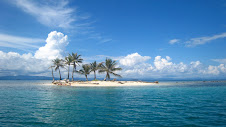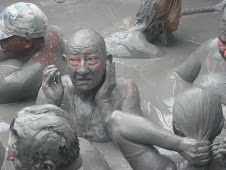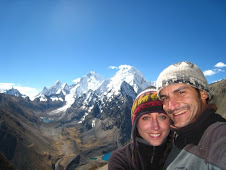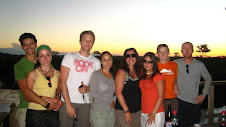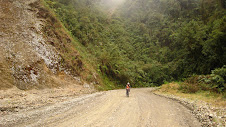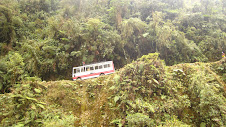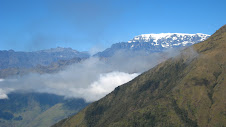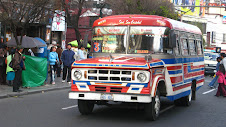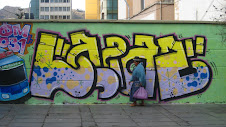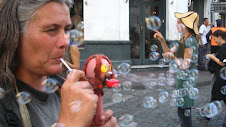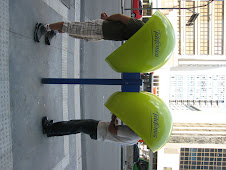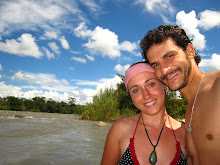Sucre was once the capital of Bolivia and is still a little resentful that its had the title taken away from it, its still the judicial capital but that doesnt have the same ring to it. Colonised by both the Spanish and the French it has some great architecture going on with Colonial buildings, a large plaza in the center of town and some pretty damn good and cheap restuarants, nice - I liike!
But at the same time the Mavrix have discovered that no city keeps our attention for long and the same was true for Sucre, our mission here was purely one of errand running. Our days would consist of trying pitching up time and again at the Bolivian consulate until it was magically open for no apparent reason, buying sleeping bags and walking whimsically through the plaza and surrounds trying to look cultured (we failed but you guessed that already).
There was also one of South Americas beloved protests the one day leading to the whole city basically having a day off as no public or private transport was functoning, stores were closed and roads blocked by trucks, rocks and sheep, not the best for Birthday shopping. The Vix was soon to have her big B-day and the M was in a tiny tizz looking for something first world in South Americas most third world country on a day when everything was closed....hmmm... no me fuking Gust!.
Thats about it for Sucre, pretty, sweet and short like a Chomp!
Friday, 27 June 2008
Monday, 23 June 2008
Potosi
We had been stuck in Uyuni for a few days seeing out the last of the Vixens bacteria belly and were keen to get the hell out of Dodgeville.
We got on the 9h30 bus to Potosi, a mere 7 hour journey, a mere pitance compared to the 20-30 hour Argentinian bus rides we had taken... or so we thought. The buses to say the very least are not of the same standard in Bolivia as they are in Argentina. We started by having to hurl our luggage up onto the roof of a bus that looked like someone had pasted 4 or 5 Mini bus taxis together, we had the only normal looking backpacks with everything else being flung up there either being in a large grain sack or wrapped in a blanket. The rest of the luggage consisted of chairs, old TVs, large plastic bags of unidentifiables food stuffs, kitchen ware and a couple kitchen sinks for luck. Most of the goods belonged to 2 Bolivian dwarf women (ok they are all dwarfs compared to us) who kept thowing more and more stuff up onto the roof. Even the locals started complaining that there was too much stuff on the roof but the bus drivers just shrugged and said this was how they did it in Bolivian (code for - deal with it Gringo!). Finally we got onto the bus clutching our still uninspected tickets to our Gringo selves. It was at this point that we realised that they didnt just overload the roof but the interior as well, more and more people kept getting on the bus, sitting in eisles (mostly ontop of more stuff the 2 Bolivian dwarf trolls had brought on board) and all around us. There was a heavy smell of Coca leaves in the air as all the locals enthusoiastically chewed but didnt ever swallow the leaf. The Vix was having a hard time getting into the swing of things, mainly because of the smell of things and the mood was cramped and guarded. We felt optimistiuc however, we were sure to get used to this and after all ....how bad could it really be? Really bad! After 2 hours on dirt and dust roads with monkey like hands of rural pensioners (if you still get a pension after you turn 100) clutching our headrests a little boy of 3 decided to vomit into a bag just next to him. The Vix felt like she wasnt far behind the 3 year old but managed to swallow her pride and a lot more. Finally after winding mountain roads, lungs filled with Coca and dust and the odd elbow from a disgruntled eisle sitter we arrived in Potosi.
There is actually an interesting story behind Potosi, it was once the worlds richest city, richer than London, Paris and Rome put together. Potosi was the engine that fired the Spanishes conquest and kept their coffers full with the worlds biggest Silver Mine in the Cerro Ricco (literal translation The Rich Hill). But with over 460 years of mining the Cerro Ricco stopped spitting out Silver and most of the wealth left the city. That is not to say that the mountain doesnt still hold minerals, it is still mined today for Tin, Sodium, Zinc and others. The sad tale of the Cerro Ricco is that the Spanish used Indigenous slaves to mine it, with 20 hours of hard labour in harsh conditions and only 4 hours sleep, many miners never coming up for air for years and dying young in the mines. Eventually the Inca slaves stopped working in protest of the harsh conditions. But the Spanish knew that the Indigenous people worshipped all sorts of gods and so they created an Idol for them and called it Dio - God in Spanish, however the Incas could not pronounce the letter D, there was no equivalent in their alphabet and so they called it Tio. Over 400 years later the miners of the Cerro Ricco still worship Tio, the idol in the guise of a Devil who rules the mines. They believe that outside the mine, God rules but inside the mine, Tio rules and if you dont give him offerings and worship him then he will dry up the minerals in the mountain and make you have an accident. The Spanishs influence is therefore still felt hundreds of years later and the indigenous peoples are still a slave to the mountain, many of them kids as young as 10 years old supporting whole families with their labour but without much future of their own as not many miners survive past their 30th year.
Great story dont you think? With such a great intro we had to go take a look ourselves and say Howzit to Tio. A tour to the mines starts in the miners market where you buy gifts for the miners, Coca leaves, cool drinks, 95% proof alchohol and Dynamite (just R10 for a stick). After a pretty cool Dynamite show we ducked into the mines and spent a few hours seeing the conditions they work in, meeting some of the hard men and having a drink with Tio. The tour was good, it helped solidify the history infront of our eyes but it was sad to see none the less.
Since that is all Potosi really has to offer we jumped on a bus the next day and crossed fingers that there was no road block on the way to Sucre.
We got on the 9h30 bus to Potosi, a mere 7 hour journey, a mere pitance compared to the 20-30 hour Argentinian bus rides we had taken... or so we thought. The buses to say the very least are not of the same standard in Bolivia as they are in Argentina. We started by having to hurl our luggage up onto the roof of a bus that looked like someone had pasted 4 or 5 Mini bus taxis together, we had the only normal looking backpacks with everything else being flung up there either being in a large grain sack or wrapped in a blanket. The rest of the luggage consisted of chairs, old TVs, large plastic bags of unidentifiables food stuffs, kitchen ware and a couple kitchen sinks for luck. Most of the goods belonged to 2 Bolivian dwarf women (ok they are all dwarfs compared to us) who kept thowing more and more stuff up onto the roof. Even the locals started complaining that there was too much stuff on the roof but the bus drivers just shrugged and said this was how they did it in Bolivian (code for - deal with it Gringo!). Finally we got onto the bus clutching our still uninspected tickets to our Gringo selves. It was at this point that we realised that they didnt just overload the roof but the interior as well, more and more people kept getting on the bus, sitting in eisles (mostly ontop of more stuff the 2 Bolivian dwarf trolls had brought on board) and all around us. There was a heavy smell of Coca leaves in the air as all the locals enthusoiastically chewed but didnt ever swallow the leaf. The Vix was having a hard time getting into the swing of things, mainly because of the smell of things and the mood was cramped and guarded. We felt optimistiuc however, we were sure to get used to this and after all ....how bad could it really be? Really bad! After 2 hours on dirt and dust roads with monkey like hands of rural pensioners (if you still get a pension after you turn 100) clutching our headrests a little boy of 3 decided to vomit into a bag just next to him. The Vix felt like she wasnt far behind the 3 year old but managed to swallow her pride and a lot more. Finally after winding mountain roads, lungs filled with Coca and dust and the odd elbow from a disgruntled eisle sitter we arrived in Potosi.
There is actually an interesting story behind Potosi, it was once the worlds richest city, richer than London, Paris and Rome put together. Potosi was the engine that fired the Spanishes conquest and kept their coffers full with the worlds biggest Silver Mine in the Cerro Ricco (literal translation The Rich Hill). But with over 460 years of mining the Cerro Ricco stopped spitting out Silver and most of the wealth left the city. That is not to say that the mountain doesnt still hold minerals, it is still mined today for Tin, Sodium, Zinc and others. The sad tale of the Cerro Ricco is that the Spanish used Indigenous slaves to mine it, with 20 hours of hard labour in harsh conditions and only 4 hours sleep, many miners never coming up for air for years and dying young in the mines. Eventually the Inca slaves stopped working in protest of the harsh conditions. But the Spanish knew that the Indigenous people worshipped all sorts of gods and so they created an Idol for them and called it Dio - God in Spanish, however the Incas could not pronounce the letter D, there was no equivalent in their alphabet and so they called it Tio. Over 400 years later the miners of the Cerro Ricco still worship Tio, the idol in the guise of a Devil who rules the mines. They believe that outside the mine, God rules but inside the mine, Tio rules and if you dont give him offerings and worship him then he will dry up the minerals in the mountain and make you have an accident. The Spanishs influence is therefore still felt hundreds of years later and the indigenous peoples are still a slave to the mountain, many of them kids as young as 10 years old supporting whole families with their labour but without much future of their own as not many miners survive past their 30th year.
Great story dont you think? With such a great intro we had to go take a look ourselves and say Howzit to Tio. A tour to the mines starts in the miners market where you buy gifts for the miners, Coca leaves, cool drinks, 95% proof alchohol and Dynamite (just R10 for a stick). After a pretty cool Dynamite show we ducked into the mines and spent a few hours seeing the conditions they work in, meeting some of the hard men and having a drink with Tio. The tour was good, it helped solidify the history infront of our eyes but it was sad to see none the less.
Since that is all Potosi really has to offer we jumped on a bus the next day and crossed fingers that there was no road block on the way to Sucre.
Wednesday, 18 June 2008
Salt Flats - 19 May - 24 May
We arrived in Tupiza ¨fresh¨ from an overnight bus ride into Bolivia and then 2 hours more once we had crossed the border. To say that we experienced some culture shock would be a gross understatement! The women are all straight out of the funny pages, not so much women as caracatures, dressed in oversized multi layered petti coats, bowlers hats ballanced at the very points of their heads, twin plaits hanging loosely over their shoulders and more wrinkles than a Sharpei puppy. The roads are cluttered with street stalls selling unidentifiable fried meats, ready made juices waiting all day in the sun just for you and every kind of llama wool jersey, sock, frock, beanie, bag or rag you can think of. In short this was more like the South America we thought we would be walking into, Argentina was quite European and civilised in many ways compared to this, more Spanish than Indigeonous. Bolivia was the real deal and cheap at the price!
With an ok nights sleep and some provisions bought we stepped into the Land cruiser that would become our home for the next 4 days as we explored the legendary Salt Flats of Uyuni and all that surrounded it. If you are looking for surreal landscapes then you come here to get spoilt! In our first three days we saw Vivid Green and Red lakes transformed into these colours by the Sodium, Sulphur and Uranium that line their bottoms. Pink Flamigos that skim the surface to get a better look at their own reflection, bubbling geysers at a breath taking (literally) 4980m above sea level, more volcanoes peaking over 6000m than anywhere on the planet, rock and bolder mazes, Dali inspired landscapes and more llamas than people in Bolivia. Ever corner seemed to hold a new sight, experience or contrast to what we had seen before. A photographers dream and a Agrophobe´s nightmare! But we were saving the best for last, the trippy crazy landscape of the worlds biggest Salt Flats was to be saved and savored on the last day of our trip, a day that started with a sunrise watched from an ancient coral island populated by cactus. You see the only way to get a giant salt flat is to plant an ocean there first then drain it fully over a few thousand years before ¨ding¨ its ready! This means you get left with a bunch of coral islands scattered here and there testifying to the once oceandom of the region and also an unnerving, bewildering flatness that goes on much further than the eye can see. Really cool! Unfortunately the Vix had been feeling horrible for the last day or so, a mixture of altitude, food poisoning and 8 hours a day stuck in a bumpy car, but she´s a trooper and was determined to get in on the Salt Flats action later. After a simple breakfast we a short drive to make sure there was nothing to see but whiteness and a the sun in the sky, we all started playing games with the lack of perspective achieved on the Salt Flats, jumping flying, playing giant or midget it was all good fun. This is a game that can take all day and is hard to get bored of unless you are the driver of a Land Cruiser that still has to get home to the wife and kids, so after a few hours of play and a lot of hooting we got into the Land Cruiser and headed for Uyuni, a little town right out of Mad Max only with Bolivians instead of Australians.
We would say goodbye here to Hari Har the German, Eimer the Irish and the MexiCAN brothers we had met along the way. Uyuni would be home for a few days much to our dismay as we waited for the Vixen the get her tummy right, something only antibiotics would eventually cure. However the Salt Flats were a definite highlight and something we will talk about for a long time to come!
With an ok nights sleep and some provisions bought we stepped into the Land cruiser that would become our home for the next 4 days as we explored the legendary Salt Flats of Uyuni and all that surrounded it. If you are looking for surreal landscapes then you come here to get spoilt! In our first three days we saw Vivid Green and Red lakes transformed into these colours by the Sodium, Sulphur and Uranium that line their bottoms. Pink Flamigos that skim the surface to get a better look at their own reflection, bubbling geysers at a breath taking (literally) 4980m above sea level, more volcanoes peaking over 6000m than anywhere on the planet, rock and bolder mazes, Dali inspired landscapes and more llamas than people in Bolivia. Ever corner seemed to hold a new sight, experience or contrast to what we had seen before. A photographers dream and a Agrophobe´s nightmare! But we were saving the best for last, the trippy crazy landscape of the worlds biggest Salt Flats was to be saved and savored on the last day of our trip, a day that started with a sunrise watched from an ancient coral island populated by cactus. You see the only way to get a giant salt flat is to plant an ocean there first then drain it fully over a few thousand years before ¨ding¨ its ready! This means you get left with a bunch of coral islands scattered here and there testifying to the once oceandom of the region and also an unnerving, bewildering flatness that goes on much further than the eye can see. Really cool! Unfortunately the Vix had been feeling horrible for the last day or so, a mixture of altitude, food poisoning and 8 hours a day stuck in a bumpy car, but she´s a trooper and was determined to get in on the Salt Flats action later. After a simple breakfast we a short drive to make sure there was nothing to see but whiteness and a the sun in the sky, we all started playing games with the lack of perspective achieved on the Salt Flats, jumping flying, playing giant or midget it was all good fun. This is a game that can take all day and is hard to get bored of unless you are the driver of a Land Cruiser that still has to get home to the wife and kids, so after a few hours of play and a lot of hooting we got into the Land Cruiser and headed for Uyuni, a little town right out of Mad Max only with Bolivians instead of Australians.
We would say goodbye here to Hari Har the German, Eimer the Irish and the MexiCAN brothers we had met along the way. Uyuni would be home for a few days much to our dismay as we waited for the Vixen the get her tummy right, something only antibiotics would eventually cure. However the Salt Flats were a definite highlight and something we will talk about for a long time to come!
Subscribe to:
Comments (Atom)











































































